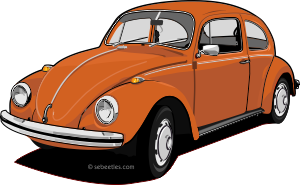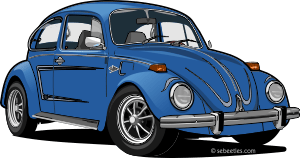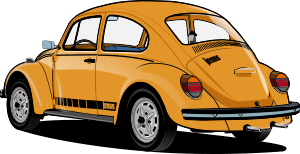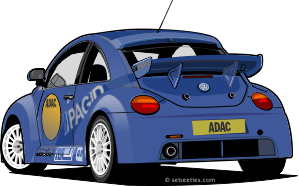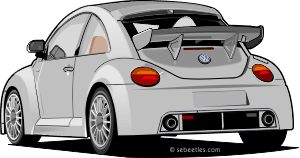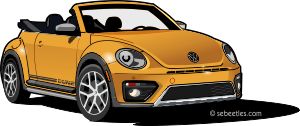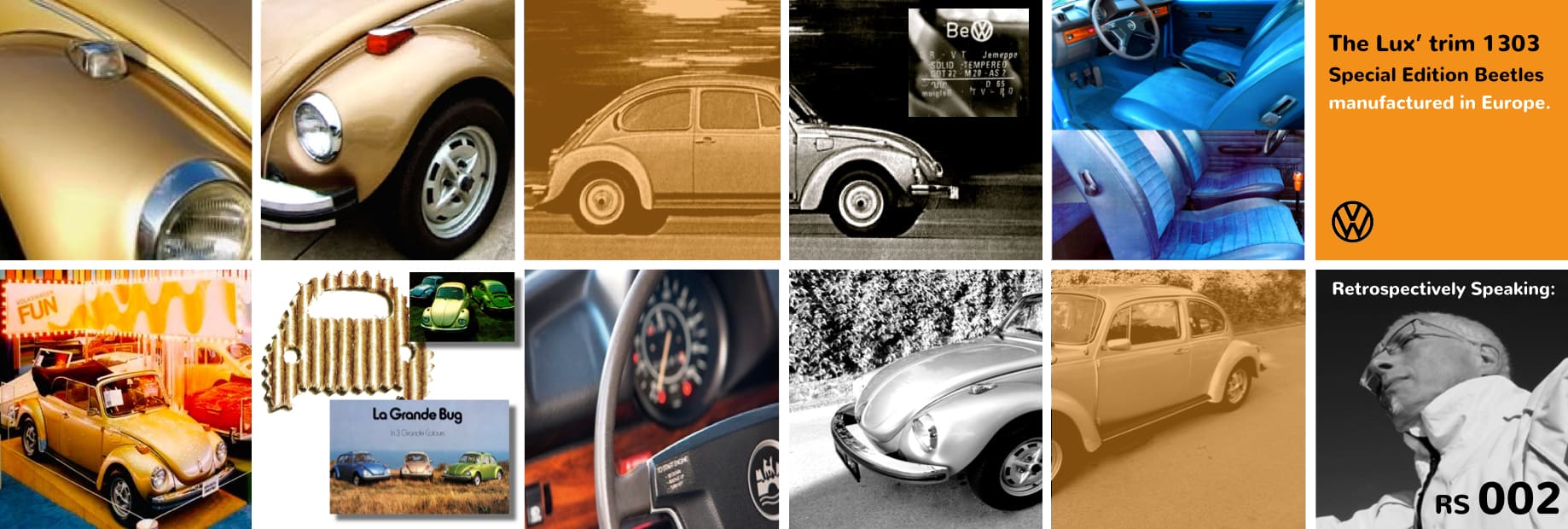
Retrospectively Speaking: The Lux’ trim embellished 1303 Special Edition Beetles manufactured in Europe.
If I was asked to give a quick overview of the themes that put “special” into the packaging of SEBs manufactured in Europe Lux’ trim embellishments would not be one of the first thoughts that came into my head. It is interesting though that this accent was actually a strong theme of several 1974/75 1303 SEBs – and lingered on through until 1979.
To put this into context perhaps we should, first, take a quick review of the normal series production 1303 model which was the final engineered development of the Beetle body shell and took the McPherson strutted 1302 Super Beetle to the ultimate level.
With a production lifespan of just three years in saloon/sedan form and seven years in cabriolet/convertible form it went through only one outwardly visible change for the European market. For the 1975 model year onwards the, by then, traditionally wing mounted front indictors were moved to the front bumper. Conversely models for the North American market retained wing mounted front indicators, albeit with much larger lenses than the European market equivalents, and integral side reflectors until the end of production. What did change on the external appearance of the North American models however was that the bumper size and it’s telescopic mounting went through a series of upgrades dictated by US and Canadian type approval legislation.
Whilst the 1303 continued the more bulbous front bonnet, complete with spare wheel laying flat, introduced with the 1302 series it brought with it completely redesigned rear wings and the largest (and final) style of rear lights fitted to any Beetle.
On the inside the seats of the 1303 were common to other contemporary Beetles in any one model year (and increasingly common to the “New Generation” water-cooled models as well) but the dashboard was totally different to that fitted to any other Beetle series. The large curved windscreen intended to preempt US legislative constraints accommodated a large padded dash area with binnacle housed speedometer. Control switches for lighting etc., were of the rocker style (again in common with contemporary water-cooled models) and set in row on a the black finished, rather plastic looking, dashboard facia.
Without a doubt the 1303 arrived at a time of dumbing down the trim levels of the Beetle range. But before trying to understand why that happened we first have to turn the clock back and look at the evolution of trim levels that set the benchmarks for normal series production model Beetles made in Europe.
In the early days of European Beetle production there were two basic models: the “standard” and “export”. By August 1965 with the introduction of the 1966 model year (and the 1300 Beetle), “export” had effectively become the “Deluxe”. The use of the term “Deluxe” in Volkswagen sales literature varied both by the market where the sales brochure was printed and for any particular model year. For example it was a familiar term in US and UK brochures in the early 60’s because those markets only got “export” (fully trimmed) models. In reality “export” or ‘Deluxe” meant a “standard” Beetle fitted during manufacture with factory “M”options of such things as chrome trim, full headlining and other equipment over and above the absolute essentials found on the standard model.
The period from August 1965 through to August 1972 saw the European manufactured Beetle in arguably it’s best levels of trim. Certainly the halcyon days of 1972 when it was at it’s sales peak coincided with the best levels of trim seen on normal series production Beetles. From August 1972 onwards economies started to become evident – the deletion of the chrome trim around the rear side air extractor vents being but one small, but aptly illustrative, example. Initially the changes were not readily apparent because with the introduction of the 1302 series (and larger 1600cc engine to replace the 1500cc unit) in August 1970 came a new era of badging that included “L” suffix for Beetles manufactured with factory orderable additional trim “M” options. This of course was in addition to the use of “S” suffix for those fitted with the 1600cc engine.
By August 1973 rationalisation and economisation across the Beetle range (indeed Volkswagen’s whole passenger car range) became even more evident with the abandonment of the older (1960’s) styled 1200 spartan Käfer and introduction of the 1200 model that had far more commonality with the flat screen 1300 in terms of bumpers (albeit black painted), large rear lights etc., The “L” option remained but the trim level of the base models to which it could be applied decreased.
Just one year later, in August 1974 for the 1975 model year all European market Beetles were altered to have bumper mounted front indicators. A change that came about partly as a result of component rationalisation to the Golf and other “New Generation” water-cooled models and partly as something we now contemporaneously call “facelift” changes to impart a degree of family likeness across a model range.
This period, August 1972 – July 1975, also saw the increasing divergence of technical and trim specifications between the Beetles destined for the North American markets and those destined for European markets. As a general theme the US and Canadian normal, series production, Beetle models coming out of the Emden plant saw an incremental accenting towards luxury trim as a way of trying to slow faltering sales and remain, more or less, competitive in the market place. By way of contrast, again as a generalisation, the accent in Europe for the comparable normal, series production, Beetle models was honed towards economy in all respects – to the point of frugality.
Volkswagen turned to the luxury, (Lux’) accent of the North American models as a theme for some SEBs as a way of setting some of the European Sales Campaign models apart from the increasingly plain, normal series production, Beetle models coming out of the Wolfsburg, Hannover and Brussels factories. Whilst all SEBs for export to North America were produced at Volkswagen Werke Emden many SEBs from the 1973/4 period for export within Europe came from the D’leteren plant in Belgium with it’s distinguishing “Be” markings in the window glass.
The additional Lux’ trim items added into several Campaign model packages generally included a higher level of upholstery trim (leatherette faced with cloth of varying finishes including velour and fine needlecord), a “sports” steering wheel with stitched, grained, padded rim and aluminium silver trim to the horn pad, dashboard with wood effect veneer trims replicating the grain pattern of various tree species, wooden or otherwise unique gearshift knob, full carpeting, retention of full chrome trim from the top line normal series production models, engine lid and glove box locks and M Pack (Z 05) comprising of heated rear window, rubber bumper inserts and anti-dazzle rear view mirror. These were added to the basic menu choices that are very recognisable SEB idiosyncrasies – the use of Lemmerz VW “GT” sports wheels and special paint colours .……
The first was the “Sportkäfer” finished in L96M Marathonblau-metallic/Marathon Blue Metallic paintwork with chrome trim fittings and 4½J x15 Lemmerz “GT” Sports road wheels. Interior details of this Edition included the sports steering wheel as used on the black trimmed S714 “Gelbschwarzer Renner” / “Yellow and Black Racer “(GSR) and it’s equally well known North American cousin the “Sports Bug”.
The “Sportkäfer” was the top line model in a trio of 1200, 1300 and 1303S Beetles that made up the “Sonderverkaufsaktion Drei Käfer auf Extra-Tour:” The Käfer Revue 1/2015 article “Käfer spezial:” gives the production period for the “Sportkäfer” as 24 March 1973 – 25 May 1973 with production quantity as 8,000 (+1,250) cars. I am uncertain if the 1,250 was a second production run.
Next up came the “Käfer der Käufer” Edition of the three SEBs launched at the Frankfurt Motor Show in late 1973 two of which came with Lux’ trim that distinctly bucked against the trends of the normal series production models in an attempt to re-energise buyer interest in the Beetle range – and boost sales.
These were the S763 Big Beetle and S764 City Beetle. The third of the trio was the S761 Jeans Beetle (I).
(So as not to distract from the theme of this particular RS column the evolutionary stages in the identity of these SEBs from pre-production to launch is subject of RS 003).
This “Käfer der Käufer” Edition repeated the theme used by Volkswagen earlier that year in the “Drei Käfer auf Extra-Tour” Edition of using a trio of Beetles as the base models: spartan 1200cc, luxe 1300cc and sports 1600cc. In doing so with both sales campaigns Volkswagen cast it’s sales net as wide as possible in terms of potential customers.
For the “Käfer der Käufer” Edition, in escalating order of power, the Jeans Beetle was in evergreen 1200cc form, the City’ a 1303 in 1300cc guise and at the top of the range, the Big’, a 1303 with it’s 1600cc “S” option (with the exception of 1300cc version specifically for Italy). In terms of market sectors the Jeans was aimed at young (or young at heart) buyers. The City’ was, true to it’s name, intended as a well appointed urban Beetle whilst the Big’ was intended to capture potential owners having a focus more on inter-urban (or sports) motoring as a follow up to the “Sportkäfer”
The City’ and Big’ had a comparable contemporary in another 1974 model – the S729 Special Edition described in the Volkswagen “S” list (“S” standing for “Sonderverkaufsaktion” or “Sonderaktion” meaning , literally, “Special sales deal” and“Promotions” respectively) as the “Sonderaktion *Luxus-Käfer*”. A 1303 Special Edition for (unspecified) export markets save for also being explicitly listed as “not for the USA or Canada”.
Slightly confusingly that same mid-1970’s era Volkswagen “S” list details another “Sonderaktion *Luxus-Käfer*” for 1975 – this time numbered S736 and being a 1303 specifically for USA and Canada. I believe, by a process of deduction, that this Edition was actually marketed as the “La Grande Bug”.
The options fitted to each of these four Editions included the Lux’ trim features described earlier – and as indeed fitted also to several more SEBs for the North American markets of USA and Canada including the 1974 Sun Bugs in both saloon/sedan and cabriolet/convertible versions.
On the matter of these Sun Bugs the Volkswagen “S” list is again confusingly unclear in that a 1303 saloon/sedan for USA was listed under S736 “Sonderaktion *Sonnenkäfer*” yet not as a cabriolet/convertible. I believe, again from deduction, that the Sun Bugs may also be embraced also within S723 “Sonderaktion für USA”.
For 1976 North American Editions that included Lux’ trim options comprised of the Bicentennial and Triple White Convertibles – both embraced by yet another “Sonderaktion für USA” package S739.
Similarly the 1977 Champagne Edition Convertible and 1978 Champagne Edition II Convertible, “Sonderaktion für USA” S723 and S765 respectively also included those now familiar Lux’ fittings – as did the 1979 Epilogue Convertible.
What I find particularly intriguing though is another common thread permeating the theme of the Lux’ trim 1303 Editions – that of the use of L97A (Z4) Diamantsilber-metallic/Diamond Silver Metallic paintwork.
The Big Beetle brochure illustrated it being available in L95C (Y6) Moosgrün-metallic, L95M (U6 )Ontario-metallic and L98C (W4) Hellas-metallic. I remember these colours appearing in the UK at the time of the Big Beetle launch supplemented later, as is where, by a second batch of Big Beetles. comprising of further Moosgrün-metallic cars together with the introduction of a fourth and predominate colour – Diamantsilber-metallic.
Whilst Moosgrün-metallic and Hellas-metallic were standard 1974 model year paint colours (at least in Germany for the 1303 range) Ontario-metallic and Diamantsilber-metallic were not.
Information available on the UK 1303 Big Beetle Register website shows that not only where there two distinct batches of frame (chassis) numbers imported together but two distinct groupings in the dates of UK first registration. The bulk of the initial importation were registered between October 1973 and March 1974. Given the practicalities of exportation, distribution and stock control this correlates well to The Käfer Revue 1/2015 article “Käfer spezial:” information that the Big Beetle production period was 15 September 1973 – 16.November 1973.
When looking at the same information source it can be seen that of the second series of Big Beetles imported into the UK the bulk of the cars were registered between June and October 1974. In addition the second batch Moosgrün-metallic and the Diamantsilber-metallic examples came with and 4½Jx15 rather than the 5½J x15 Lemmerz “GT” sports wheels normally associated with the Big Beetle Edition. Other minor differences included rubber bumper strip and the standard plastic gear shift knob instead of the wooden version shown in the Big Beetle brochure. These Diamantsilber-metallic aroused my inquisitiveness and a bit more delving turned up solid evidence of a silver Big Beetle carrying the S729 option code on it’s delivery documentation rather than the expected S763 code.
This discovery started to make a lot of sense – and linked the Diamantsilber-metallic Big Beetles to that Edition supplied into several “export” markets listed as the “S 729 “Sonderaktion *Luxus-Käfer* Export-Länder nicht USA, Kanada 1303: 135, 136”
The end result of this research is that SEB history has to be rewritten – certainly as far as the UK is concerned. Those later batch of Moosgrün-metallic and Diamantsilber-metallic cars that for 40 years had been considered Big Beetles were in fact S 729 *Luxus-Käfer* but because UK Big Beetles had the plain side stripe, as did the *Luxus-Käfer*, it seems nobody particularly noticed and they came to be assumed just “more of the same”.
We know for certain that L97A (Z9) Diamantsilber-metallic Luxus-Käfers were exported to Austria because details of an example complete with reputable provenance bolstered with a Volkswagen “Zertifikat”were recently sent to SEBeetles by it’s Austrian owner. This 1303S model appears very similar to the Big Beetle in many respects save for not having and side stripe decal, having Lapisblau (56) leatherette faced upholstery rather than the velour seats of the Big Beetle, and Lemmerz “GT” sports wheels of 4½Jx15 rather than 5½J x15.
Irritatingly the Volkswagen “S” list does not elaborate on which countries were included in the all embracing term “Export-Länder” for the S 729 “Sonderaktion *Luxus-Käfer*” We believe however that this edition was sold in the at least Denmark, Belgium, Switzerland, Austria and Italy (model 1303:135) together with UK and Japan (model 1303:136). Marketing was variously either as part of the Big Beetle Edition or, as in Austria, simply as a Luxus’. Continuing this line of thought then it is highly possible that the “S 729 “Sonderaktion *Luxus-Käfer*” edition comprised of not just Diamantsilber-metallic cars but Moosgrün-metallic ones as well.
To compound the confusion the Austrian owner of this Diamantsilber-metallic 1303 Luxus-Käfer tells us that Volkswagen informed him that 12,000 Luxury Beetles were manufactured for the domestic market (“inland” – Germany) and 8,000 for export. Curiously the Volkswagen “S” list does however not include a S 729 “Sonderaktion *Luxus-Käfer*” for “inland” (Germany) and the listing in the excellent “Käfer spezial” article in Käfer Revue 1/2015 does not detail any 1303 for the home market in 1974 that correlates with Volkswagen’s claimed 12,000 unit production. All this then leaves us with still more unanswered questions.
During 2015 one of the automotive importers specialising in bringing second-hand/pre-owned cars into the UK from Japan (a convenient source of imports into the UK because Japan also drives on the left and therefore is a RHD market) advertised a sliver metallic 1303S for sale that had most of the option details that we associate with Big Beetles – together with idiosyncratic requirements of the Japanese home market and perforated front apron option M550. It would appear therefore it is an example of S729 “Sonderaktion *Luxus-Käfer* “export” 1303: 136”
My final musing on the subject of 1303 Lux’ trim Editions and the use of Diamantsilber-metallic relates to the legacy of the 1975 La Grande Bug.
This Edition contrasted noticeably with it’s companion normal series production North American Beetle contemporaries on account of it’s metallic paintwork (and Lux’ trim). It was available in L96N (Y5) Vipergrün-metallic, L97B (X5) Ancona-metallic and (for Canada) L98C (W4) Hellas-metallic which set it apart from the predominately bright shades of solid colour in the normal series North American paint charts from the same year. Interestingly also is the fact that the Canadian brochure for this SEB featured three cars (from left to right across the front cover) in blue, gold and green which by coincidence was exactly the same sequence as the in photograph of the initial three paint colours shown in the Big Beetle brochures.
The following year,1976, and the penultimate year for sedan/saloon Beetles in North America, the normal series paint ranges were reduced and divided. The 1303 cabriolet/convertible was offered in 4 bright, solid, colours (combined with standard road wheels) and the single remaining, flat screen, sedan/saloon Beetle in three metallic colours (combined with 4.5Jx15 Lemmerz “GT” sports wheels). These three colours with Lemmerz wheels emulated, to a large degree, the previous year’s La Grande Bug theme but in L96N (Y5) Vipergrün-metallic (called Lime Green in the sales brochures), L99D (D1) Topas-metallic (Topaz – not dissimilar to Hellas’) and L97A (Z4) Diamantsilber-metallic.
For 1977 and it’s final year of importation into North America the flat screen sedan/saloon was again only imported in three metallic colours with L99F (Y3) Bahamablau-metallic replacing Topas Metallic as companion to the previous year’s Vipergrün-metallic and Diamantsilber-metallic. Again, also as in the previous year, they were shod with 4.5Jx15 Lemmerz “GT” sports wheels. The normal series 1303 cabriolet/convertible for North America however remained available only in bright, solid, colours (and standard road wheels) through to the end of importation giving plenty of scope for a very noticeable difference with visual impact of the Special Edition Lux’ trim/Sports wheel shod Champagne, Triple White and Epilogue Edition cabriolets/convertibles.
Appreciation: My grateful thanks to fellow SEB enthusiast Jan Walter for his encouragement and help with research and information. His help, which has prompted several revisions to my draft text, has helped to make this column a more extensive history of Big Beetle and Luxus-Käfer production than we have previously been able to record.
Copyright Stephen Paul Hardy,
Dorset, England. 28th March 2016
(Amended 13th June 2016 in respect of late series Moosgrün-metallic and Diamantsilber-metallic UK “Big Beetles” actually being S 729 *Luxus-Käfer* and the addition of the “Sportkäfer”)
Further reading on this website:
The individual profiles for each of the SEBs mentioned in this column.
“Articles” sections E1.0, E1.1, E1.2, E1.3, E1.5, E1.6, Type1 M Codes List and Type1 S Codes
Retrospectively Speaking 003
